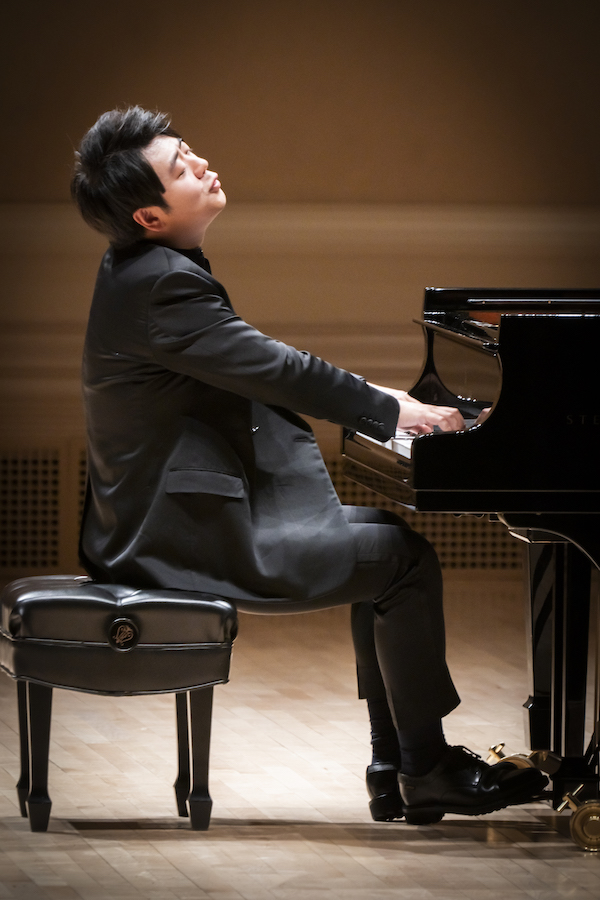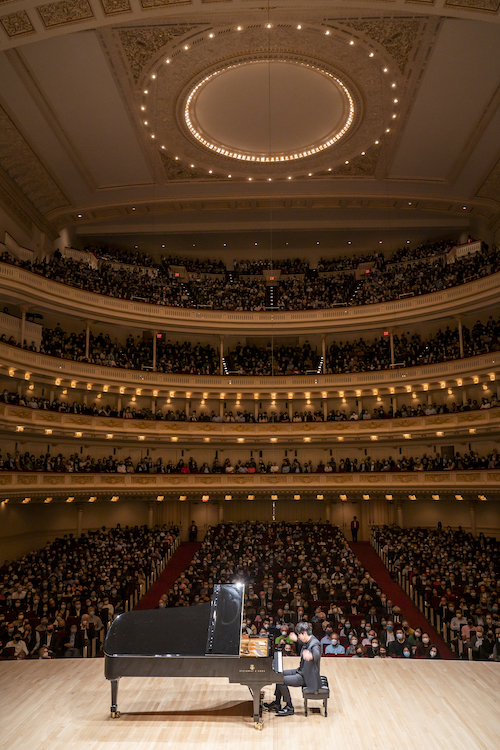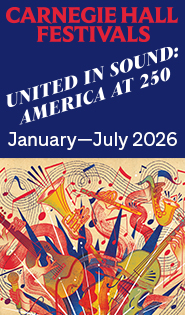Lang Lang explores a world of nuance and imagination in Bach’s “Goldbergs”
The “Goldberg” Variations? Lang Lang? Really?
Really. The fleet-fingered Chinese pianist, the Fresh Prince of Razzle-Dazzle, left all mugging and mannerisms at the Carnegie Hall stage door Tuesday night, and settled in for a long, imaginative—and yes, sometimes dazzling—traversal of J.S. Bach’s colossal keyboard work.
And we do mean long. Advance information from Carnegie Hall listed the duration of the “Goldbergs” as “approximately 50” minutes. On the night, it was at least twice that, owing to the pianist’s observing all the indicated repeats—most performers skip some or all of them—and taking daringly slow tempos in the adagios.
Late in the performance, as the pianist slowly rounded the bend in a deeply introspective, glacially paced, pianissimo rendering of the intensely chromatic Variation 25—slowing even further for the cadence, pausing, then beginning the repeat of that section even more pianissimo than before—a few patrons gathered their coats and exited.
Maybe they had a train to catch, or this heady stuff wasn’t the kind of athletic fun they associated with the Lang Lang brand. The vast majority of the audience stuck with this performance through thick and thin, fast and slow.
The pianist made it easier for them with an endless variety of tones, colors, and voicings. That’s the reason for repeats in the first place: music, like love, can be better the second time around. Play it again—this time legato instead of staccato, or with a splash of pedal, or whisper it pianissimo, or point up that bossy bass line and the little tune hidden in the middle.
In this way, the work’s 62 repeats—two sections of the opening Aria, and the same for each of the 30 variations on it—can be transformed from a recipe for tedium to an enchanted playground of the imagination. Lang Lang and his listeners spent most of the evening outside at play, so to speak.
Perhaps for no other reason than to warm up the pianist’s fingers, the recital began with a brief piece by Schumann, the agreeable Arabeske. (Coincidentally, the harpsichordist Ralph Kirkpatrick has described the light and speedy variations in “Goldberg” as “arabesques.”) True to his past form, Lang Lang burdened this Viennese trifle with exaggerated tempo fluctuations and loud-soft contrasts, going big where other pianists might seek nuance. The performance seemed to presage a similar, primary-color “Goldberg.”
Instead, the pianist sat still, and the evening’s focus shifted from what was happening on the piano bench to what was coming out of the instrument. Lang Lang imbued every moment of the long work with a sense of direction and purpose, be it lyrical or motoric.
The delicate additional ornaments in the repeats of the Aria suggested that the pianist knew his Couperin. And one sensed one was in for a different brand of piano wizardry when his right hand played a canon with itself in Variation 3, distinguishing the two voices by tone color.
The scales of Variation 5, which swirled while a leaping left hand poked out tunes above and below, evoked the interplay of shapes in Baroque architecture. Throughout the evening, Lang Lang kept an eye on the overall shape of what he was creating, however busy the details.
This included swirling ahead into a faster-than-usual Variation 6, the better to contrast with the dainty charm of the French gigue in Variation 7, punctuated by sparkling little rocket scales. Later, near the end, a buildup of momentum blew away the separations between Variations 26 through 29, as a blur of sixteenth notes grew to a roar of interlocking chords to (almost) close the piece.
It was an eventful trip to those cathartic pages. There were Chopinesque moments, as in the lush-toned legato treatment of the canon in Variation 9, and even hints of Debussy in the gentle shower of scales of Variation 11.
Face tilted upward, Lang Lang seemed to be listening intently to the florid vocal line of Variation 13, a sarabande. He imposed no swoopy rubato on it, and yet the performance felt free, unfolding in the moment.
Not spreading the pathos too thick, the pianist outlined the minor-key Variation 15 with a dry brush, closing the work’s first half on a note of suspense. Then he exulted in the fresh start of Variation 16, a bold French overture, tapping his left foot as he snapped out the regal rhythms. In contrast, the shapely phrases of Variation 17 waved like fronds.
Contrasts continued to abound, from the scurrying mice of Variation 20 to the funereal tread of Variation 21, and from Variation 23’s capricious spurts to the overlapping Baroque arches of Variation 24. Perhaps some watches were being checked during the glacial Variation 25, but for other listeners time seemed to stop altogether.
One could also imagine divided opinion on how Lang Lang chose to close the work, casting a nostalgic haze over the humorous Quodlibet (Variation 30), with its admixture of (possibly bawdy) folk songs, then reprising the Aria in a vaporous pianissimo, without repeats. It’s likely some listeners found this ravishing, while to others (this one included) it sounded jarringly sentimental.
In any case, Lang Lang had earned his ovation at the end. He responded with two encores: Beethoven’s “Für Elise,” rather fetchingly Chopinized, and the Peter Schindler arrangement of the traditional Chinese song “Jasmine Flower,” with some Lisztian pyrotechnics tacked on at the end, courtesy of the artist. He might as well have titled it “Für My Fans.”
The Orchestra of St. Luke’s conducted by Bernard Labadie, with violinist Benjamin Bowman, performs works of Charpentier, J.S. Bach, and Handel at Carnegie Hall, 8 p.m. Thursday. carnegiehall.org; 212-247-7800.



